Book contents
- Handbook on Good Treaty Practice
- Reviews
- Centre for International Law, National University of Singapore (CIL-NUS)
- Handbook on Good Treaty Practice
- Copyright page
- Contents
- Contents
- Figures
- Boxes
- Acknowledgements
- Table of Cases
- Table of Treaties and other International Instruments
- Table of Legislation
- Abbreviations
- 1 Introduction to Good Treaty Practice
- 2 Organising Treaty Work in Governments and International Organisations
- 3 Treaties and Other Kinds of International Instruments
- 4 Managing and Using Treaty Collections
- 5 Making a New Treaty: Negotiation, Drafting and Production
- 6 Preparing to Become Party to a Treaty
- 7 Becoming Party to a Treaty: Consent to Be Bound and Entry into Force
- 8 Continuing Engagement with the Treaty Throughout Its Life
- 9 Ending Treaty Relations
- 10 The Future of Treaty Practice
- Annexes
- Glossary
- Suggested Further Reading
- Index
5 - Making a New Treaty: Negotiation, Drafting and Production
Published online by Cambridge University Press: 27 January 2020
- Handbook on Good Treaty Practice
- Reviews
- Centre for International Law, National University of Singapore (CIL-NUS)
- Handbook on Good Treaty Practice
- Copyright page
- Contents
- Contents
- Figures
- Boxes
- Acknowledgements
- Table of Cases
- Table of Treaties and other International Instruments
- Table of Legislation
- Abbreviations
- 1 Introduction to Good Treaty Practice
- 2 Organising Treaty Work in Governments and International Organisations
- 3 Treaties and Other Kinds of International Instruments
- 4 Managing and Using Treaty Collections
- 5 Making a New Treaty: Negotiation, Drafting and Production
- 6 Preparing to Become Party to a Treaty
- 7 Becoming Party to a Treaty: Consent to Be Bound and Entry into Force
- 8 Continuing Engagement with the Treaty Throughout Its Life
- 9 Ending Treaty Relations
- 10 The Future of Treaty Practice
- Annexes
- Glossary
- Suggested Further Reading
- Index
Summary
The chapter addresses the phases in making a new treaty: negotiation, drafting and production of the text. It discusses how to prepare for treaty negotiations and how to influence the drafting effectively, differences in the making of multilateral and bilateral treaties, and identifying the main actors involved in negotiating and drafting a new treaty. It explains in detail how to structure a treaty text, including title, preamble, final clauses, testimonium, signature block. It then examines the process of preparing and producing a treaty text for signature, including adoption, translation, formatting, binding and sealing. At each stage the role of the Treaty Office is highlighted. The importance of Full Powers is explained, as well as how to produce them and when it is permissible to dispense with them. Lastly, the chapter provides useful checklists for Treaty Offices and depositaries in making new bilateral and multilateral treaties.
Keywords
- Type
- Chapter
- Information
- Handbook on Good Treaty Practice , pp. 158 - 202Publisher: Cambridge University PressPrint publication year: 2020

